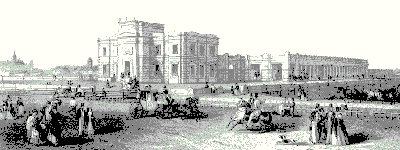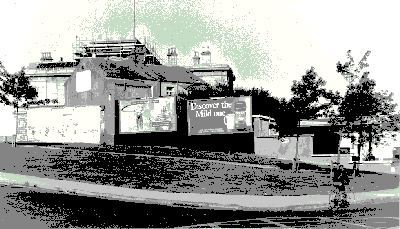
| "The Broadstone Station is the last building in Dublin to partake of the sublime. Its lonely grandeur is emphasised now by its disuse as a terminus, and the melancholy quarter of high-and-dry hotels beside it. It stands on rising ground, and the traveller who sees it for the first time, so unexpected in its massive amplitude, feels a little as he might if he were to stumble unawares upon the monstrous silences of Karnak or Luxor". |
So writes the historian Maurice Craig, in his "Dublin 1660-1860".
|
At the western end of Western Way, once an avenue leading to the railway
terminus, lies the magnificant Broadstone Station. This marvellous building,
situated where Constitution Hill becomes Phibsborough Road, lies directly
opposite Gandon's Kings Inns. It was designed by one of Ireland's most
illustrious architects, John Skipton Mulvaney, as the terminus of the
Midland and Great Western Railway.
Designed in the Egyptian style, the main building was completed in 1850.
Previously, the site had been known as Broadstone Harbour, the terminus of
the Royal Canal.
With Galway projected to become the main port for transatlantic passenger traffic between Europe and North America, the Midland successfully competed with the Great Southern to reach it first. A special fourth class was introduced by the Midland for dirt-poor migrants from the west going to Britain for work. The line, which branched out to serve Sligo, Westport, Achill and Clifden, was also used to transport huge numbers of cattle. The remarkable colonnade, which came to be used as a stand for jarvey-cabs, was added in 1861. From 1872, the Midland built its own locomotives at Broadstone. Like the Broadstone Harbour before it, the Broadstone Station in turn fell victim to another transport revolution. The golden age of Irish railways was drawing to a close, road transport was taking over and lines were being closed. At midnight on January 16th, 1937, the night mail from Westport was the last train to arrive at Broadstone. |

| Today, the historic Skipton building is used as offices by Bus Éireann and the rest of the site is used a parking and servicing area for busses. Unfortunately, the vista which Maurice Craig describes so enthusiastically is almost entirely obscured by a petrol station, the ragged rear-end of some shops, and an array of advertising hoardings. |